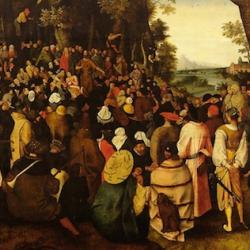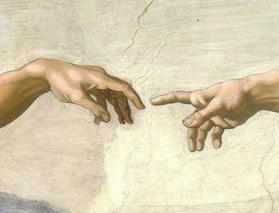Notes on Georg Simmel, “Faithfulness and Gratitude,” printed in Kurt H. Wolff, The Sociology of Georg Simmel (Free Press, 1950).
1) Simmel describes faithfulness as “the inertia of the soul.” Less impressionistically, faithfulness is “the peculiar feeling which is not directed toward the possessor’s eudaemonistic good, nor toward the other’s welfare as an extrinsic, objective value, but towards the preservation of the relationship to the other. It does not engender this relationship; therefore, unlike . . . other affects, it cannot be pre-sociological: it pervades the relation once it exists and, as its inner self-preservation, makes the individuals-in-relation hold fast to one another.”
2) To develop his understanding of faithfulness, Simmel distinguishes between the initiation of a relationship and its continuance or endurance through time. Faithfulness seeks to preserve the relationship through time, when the affections and moods that might have initiated the relationship may have evaporated. Unlike other relational affections, faithfulness in the sense Simmel uses the word (and he recognizes alternative meanings) is not something exchanged between the parties of the relationship; it is rather the attitude that each takes toward the relationship itself. He recognizes that there are other factors that preserve a relationship (the original affections may continue, legal constraints may demand that the relationship continue, social constraints – risk of shame or embarrassment may be a factor). Faithfulness is specifically the “affective factor” among the other factors that preserve a relationship through time.
3) Simmel suggests that togetherness over time itself leads to the “induction” of the state of faithfulness: “mere habitual togetherness, the mere existence of a relation over a period of time, produces this induction by feeling.” On the other hand, he also makes the intriguing point that faithfulness in a relationship might ultimately generate other feelings between the parties in the relationship. The “banal wisdom” that people who marry out of obligation will grow to love one another, he claims is “quite apt”: “once the existence of the relationship has found its psychological correlate, faithfulness, then faithfulness is followed, eventually, also by the feelings, affective interests, and inner bonds that properly belong to the relationship. Only, instead of appearing at the beginning, as we should ‘logically’ expect, they reveal themselves as its end product.”
4) Simmel sees faithfulness as a fairly unique sociological/psychological phenomenon that incorporates the stability of external social reality into the soul. He sets up this point by distinguishing between the fluctuations of the soul and the “constantly developing life-process” and, on the other hand, the stable forms of social life. The two do not move in tandem. (Simmel describes this dualism as “tragic.”) Law is by nature stable and relatively inflexible (which it must be to do what it needs to do in society), and thus cannot keep pace with the shifts and changes of actual human life. Faithfulness, however, is a bridge between these two features of society: “it “has the significance that, by virtue of it, for once the personal, fluctuating inner life actually adopts the character of a fixed, stable form of relation. Or vice versa: this sociological fixity, which remains outside life’s immediacy and subjective rhythm, here actually becomes the content of subjective, emotionally determined life. Irrespective of the innumerable modifications, deflections, intermixtures of concrete destinies, faithfulness bridges and reconciles that deep and essential dualism which splits off the life-form of individual internality from the life-form of sociation that is nevertheless borne by it. Faithfulness is that constitution of the soul . . . by means of which it fully incorporates into itself the stability of the super-individual form of relation and by means of which it admits to life, as the meaning and value of life, a content which, though created by the soul itself, is, in its form, nevertheless bound to contradict the rhythm or un-rhythm of life as actually lived.”
5) Simmel defines gratitude in contrast to contracted legal obligations. Human contacts, he argues, “rest on the schema of giving and returning the equivalence.” Where the required return is legally demanded, gratitude is not operative; but where the legal obligation is absent, gratitude appears to “establish the bond of interaction, of the reciprocity of service and return service, even where they are not guaranteed by external coercion.” (This is questionable: I, for one, feel grateful to the mechanics who fix my car, despite the fact that I have also paid for the service. Simmel’s gratitude-free exchange seems to rest on a distorted view of capitalist exchanges, in which, he claims “personal interaction recedes altogether into the background, while goods gain a life of their own.” This may be true, and money may tempt us to ignore the personal context. But I am loyal to and grateful to my regular mechanic, not to mention the guy who keeps fixing my well pump.) Alternatively, Simmel describes gratitude as the return on an exchange where the “interaction is lifted out of the spontaneous act of correlation through the exchange of things.” He points out that gratitude might even move beyond a response to specific favors, for we can be grateful to people we don’t know (as I am to Augustine and Calvin) and be grateful for the sheer existence of another person.
6) In another striking aphorism, Simmel describes gratitude as “the moral memory of mankind.” It is the continuance of a relationship built on an interaction of exchange (not necessarily of objects) into the present and future. Gratitude connects human actions “with what has gone before, it enriches them with the element of personality, it gives them the continuity of interactional life.” If grateful response were eliminated “society (at least as we know it) would break apart.” Common gratitude toward a benefactor creates not only bonds between the benefactor and recipients, but among the recipients. (Think Eucharist.)
7) In a footnote, Simmel offers this compact description of the sociological centrality of giving, emphasizing the giving is necessarily an interaction, an exchange, and never simply unilateral: “giving is by no means only a simply effect that one individual has upon another: it is precisely what is required of all sociological functions, namely, interaction. By either accepting or rejecting the gift, the receiver has a highly specific effect upon the giver. The manner of his acceptance, gratefully or ungratefully, having expected the gift or being surprised by it, being satisfied or dissatisfied, elevated or humiliated – all this keenly acts back upon the giver, although it can, of course, not be expressed in definite concepts and measures. Every act of giving is, thus, an interaction between giver and receiver.”
8) Simmel recognizes that exchanges involving gratitude are not always, perhaps never, exactly equivalent, and suggests that the inequality of gift and return gift tends to move the gift-gratitude exchange in the direction of a purchase. A man shares his mind with another, and the other loves him in return; and Simmel sees in this the shadow of a “purchase” of love.” But this shadow is dispelled once the specific realities exchanged are seen in context. “Man is not the merchant of himself,” and his abilities “do not simply lie before him like merchandise on a counter.” In giving his powers or abilities, he is giving himself &#
8220;in the form of this single energy or attribute.” Man is able to “offer and accept, by mans of the apparently objective response to the gift which consists in another gift, all of the subjectivity of gift and giver.” Gratitude can be a response not to the thing or benefit given, but a response to the relationship with the giver that comes to realization in the exchange.
9) Simmel also reflects on the asymmetry between an original gift and a return gift. The first give, he suggests, is free, but the second is coerced at least by the obligation of gratitude. (This is questionable too: No human gift is purely original, but always a response of some sort to the prior gift of existence and all that this entails.) Simmel argues that the obligatory nature of the second gift, of gratitude, is one of the reasons people refuse gifts I the first place – they are refusing the bondage, the “character indelebilis” (Simmel’s term!) that comes with receiving the first gift. And this obligation is “irredeemable” precisely because the recipient can never replicate the freedom of the first gift; his gift will NEVER be equivalent, balancing the gift he’s received. Gratitude thus has a unique force: “gratitude is perhaps the only feeling which, under all circumstances, can be morally demanded and rendered. If by itself or in response to some external reality, our inner life has made it impossible for us to continue loving, revering, esteeming a person (aesthetically or ethically or intellectually), we can still be grateful to him, since he once gained our gratitude. To this demand we are (or could be) unconditionally subject: in regard to no fault of feeling is an unmitigated sentence as appropriate as in regard to ingratitude.”
This has interesting theological implications. If gratitude is unique in the way Simmel suggests, then human beings, who have nothing they have not received, and who cannot return the ABSOLUTELY free gift of creation, are under a binding, indestructible obligation to return. Among other things, this provides one angle on original sin: Recipients of gifts, fallen man feels himself under obligation of gratitude, and yet hates the dependence and demand that this imposes, and yet hates the giver whose gift makes his hate possible. Original sin means being galled at the mercy of God.















